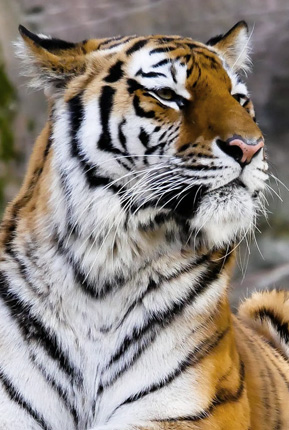
All Animals

The Tiger: Majestic Apex Predator of the Jungle
The tiger, with its striking appearance and formidable presence, is one of the most iconic and powerful predators in the animal kingdom. As the largest member of the cat family, Tigers embody strength, beauty, and grace. They are native to the diverse forests and grasslands of Asia, where they play a crucial role in maintaining the balance of their ecosystems.
Tigers are renowned for their distinctive orange coat with black stripes, which provides them with effective camouflage in the dappled light of their natural habitat. Each tiger’s stripe pattern is unique, much like human fingerprints, making it possible to identify individuals based on their markings. Their powerful bodies are built for stealth and strength, with muscular limbs, sharp claws, and strong jaws adapted for hunting large prey.
There are several subspecies of tigers, each adapted to different environments across Asia. The Bengal tiger, found primarily in India, is the most numerous, while the Indochinese, Malayan, Siberian, and Sumatran tigers are also critically important in their respective regions. Each subspecies faces unique conservation challenges, but all tigers are endangered due to habitat loss, poaching, and human-wildlife conflict.
Tigers are solitary hunters with a diet that primarily consists of large herbivores such as deer, wild boar, and water buffalo. They rely on their exceptional stealth and strength to stalk and ambush their prey, often launching a powerful sprint to deliver a fatal bite. Their keen senses of sight and hearing aid them in detecting prey and avoiding potential threats.
The reproductive cycle of tigers is marked by elaborate courtship and territorial behaviors. Female tigers, or tigresses, usually give birth to a litter of two to four cubs, which are born blind and dependent on their mother for care. The cubs remain with their mother for approximately two to three years, during which they learn essential hunting and survival skills before dispersing to establish their own territories.
Despite their status as apex predators, tigers face significant threats in the wild. Habitat destruction due to logging, agriculture, and urbanization has reduced their range and fragmented their habitats. Poaching for their bones, skin, and other body parts, driven by illegal wildlife trade, further exacerbates their plight. Additionally, human-wildlife conflict often arises when tigers prey on livestock, leading to retaliatory killings.
Conservation efforts are crucial to protecting tigers and their habitats. Initiatives include anti-poaching patrols, habitat restoration, and the establishment of protected areas and wildlife corridors. Organizations and governments worldwide are working to address these challenges, raise awareness, and promote sustainable practices that benefit both tigers and local communities.
Tigers also hold a special place in cultural and symbolic contexts. They feature prominently in myths, folklore, and art across Asia, often representing power, courage, and royalty. Their majestic presence and the urgency of their conservation needs highlight the importance of preserving these magnificent animals and the biodiversity of their habitats.
In summary, the tiger, with its majestic appearance and vital ecological role, remains a powerful symbol of wildlife conservation. Its strength, beauty, and solitary nature underscore the importance of protecting these apex predators and their environments. By supporting conservation efforts and fostering a deeper appreciation for tigers, we contribute to the survival of this iconic species and the preservation of the natural world.
